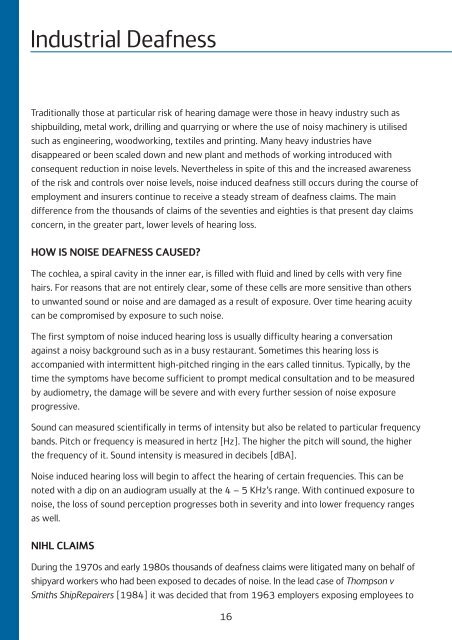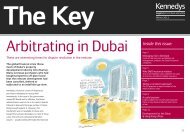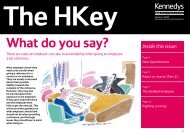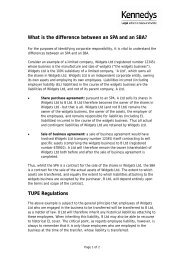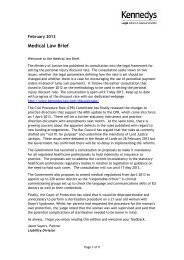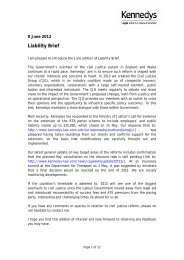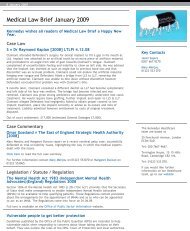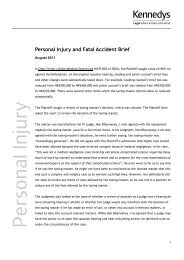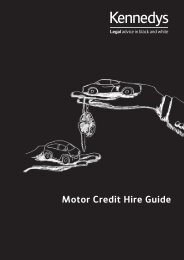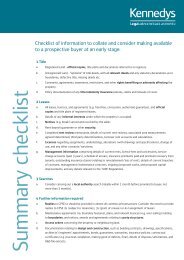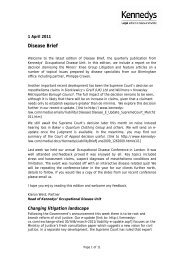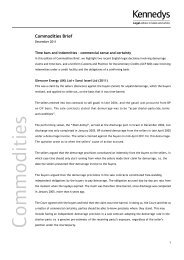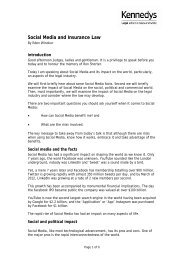Download our Occupational Disease Manual (PDF ... - Kennedys
Download our Occupational Disease Manual (PDF ... - Kennedys
Download our Occupational Disease Manual (PDF ... - Kennedys
You also want an ePaper? Increase the reach of your titles
YUMPU automatically turns print PDFs into web optimized ePapers that Google loves.
Industrial Deafness<br />
Traditionally those at particular risk of hearing damage were those in heavy industry such as<br />
shipbuilding, metal work, drilling and quarrying or where the use of noisy machinery is utilised<br />
such as engineering, woodworking, textiles and printing. Many heavy industries have<br />
disappeared or been scaled down and new plant and methods of working introduced with<br />
consequent reduction in noise levels. Nevertheless in spite of this and the increased awareness<br />
of the risk and controls over noise levels, noise induced deafness still occurs during the c<strong>our</strong>se of<br />
employment and insurers continue to receive a steady stream of deafness claims. The main<br />
difference from the thousands of claims of the seventies and eighties is that present day claims<br />
concern, in the greater part, lower levels of hearing loss.<br />
HOW IS NOISE DEAFNESS CAUSED?<br />
The cochlea, a spiral cavity in the inner ear, is filled with fluid and lined by cells with very fine<br />
hairs. For reasons that are not entirely clear, some of these cells are more sensitive than others<br />
to unwanted sound or noise and are damaged as a result of exposure. Over time hearing acuity<br />
can be compromised by exposure to such noise.<br />
The first symptom of noise induced hearing loss is usually difficulty hearing a conversation<br />
against a noisy background such as in a busy restaurant. Sometimes this hearing loss is<br />
accompanied with intermittent high-pitched ringing in the ears called tinnitus. Typically, by the<br />
time the symptoms have become sufficient to prompt medical consultation and to be measured<br />
by audiometry, the damage will be severe and with every further session of noise exposure<br />
progressive.<br />
Sound can measured scientifically in terms of intensity but also be related to particular frequency<br />
bands. Pitch or frequency is measured in hertz [Hz]. The higher the pitch will sound, the higher<br />
the frequency of it. Sound intensity is measured in decibels [dBA].<br />
Noise induced hearing loss will begin to affect the hearing of certain frequencies. This can be<br />
noted with a dip on an audiogram usually at the 4 – 5 KHz’s range. With continued exposure to<br />
noise, the loss of sound perception progresses both in severity and into lower frequency ranges<br />
as well.<br />
NIHL CLAIMS<br />
During the 1970s and early 1980s thousands of deafness claims were litigated many on behalf of<br />
shipyard workers who had been exposed to decades of noise. In the lead case of Thompson v<br />
Smiths ShipRepairers [1984] it was decided that from 1963 employers exposing employees to<br />
16


